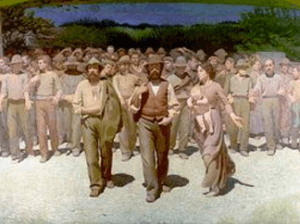The Supreme Court issued a ruling dated 20 July that serves to clarify certain aspects which until now appeared obscure and confused. The doctrine to be applied from now on concerns the acceptability of a company’s decision to use employees from other corporate work centres to replace employees who exercise their right to strike during the consultation period of a collective redundancy, determines the nullity of the dismissal in question.
This was stated by the Plenary of the Labour Chamber of the Supreme Court in a ruling dated 20 July 2016 (case number 689/2016, reporting judge Mr Blasco Pellicer), confirming the Madrid Supreme Court ruling of 29 June, 2015, which ruled on the nullity of the 121 dismissals carried out by a Madrid-based company.
The facts of the situation were as follows. The defendant informed workers’ representatives at one of their work sites of their intention to start the collective redundancy process, requiring them to communicate to management the members of the negotiating committee for the purpose of initiating the consultation period stipulated in Article 51.2 of the Workers’ Statute.
The same day the commission was established, the workers from the affected work site declared an indefinite strike, and it was at that time that workers from other corporate sites were called in to perform tasks at the site in question.
According to the Supreme Court, this action by the company triggered a situation of internal strike-breaking that rendered management’s power abusive, given the simultaneous development of a bargaining process whose purpose was, under the law, to find solutions geared toward reducing or mitigating the effects of collective redundancies. More importantly, the action was deemed to be a breach of the company’s obligation to negotiate in GOOD FAITH.
Specifically, this business conduct “affected the consultation period, depriving the workers’ representative engaged in negotiations from any strength and possible effectiveness in the context of a strike used as a legitimate means of pressure in the face of the group’s proposed dismissals and plant closures, whereby indeed the object was substantially limited, the essential purpose that the repeated consultation time is attributed both in Article 2.2 of the 98/59 [sic], as in Article 51.2 of the Workers’ Statute, which should always involve at least the possibilities of avoiding or reducing collective redundancies, as has been repeatedly underscored by the jurisprudence of this Court”.
The Court, reiterating the case law in its rulings dated 20 April, 2015 and 18 March, 2016 states that “in this scenario it is clear that the alteration of the terms of the consultation period by the conduct undertaken by the group of companies neutralised or undermined the effect of a strike directly related to the attempt by workers’ representatives to avoid or lessen the effects of dismissal, inevitably altered the terms of the negotiations which ultimately failed in some of its points”.
On these grounds, the Chamber concludes, “the plea is therefore rejected, which requires, as a necessary consequence, confirmation of the annulment of the collective redundancy on the grounds of a violation of the fundamental right to strike, as provided in Article 124.11, fourth paragraph of the LRJS law”.
The debate that may arise from this ruling is whether respect for the right to strike should prevail during the negotiation of workforce downsizing plans over the company’s organisational and commercial right to prevent such a situation from having an economic impact and to what extent the company’s actions are more or less harmful to the negotiation than workers’ actions.
I deem it inarguably necessary to decide on a case-by-case basis and not make general assessments to determine the REVOCATION of the redundancies.

The Fourth Estate. Giuseppe Pellizza da Volpedo. 1901. Museo del Novecento, Milan
